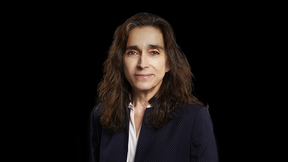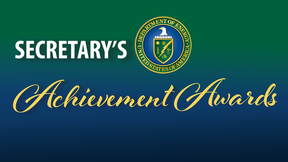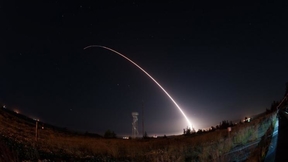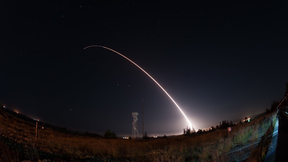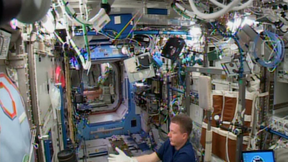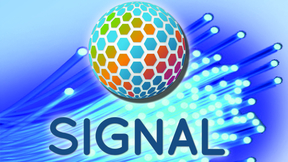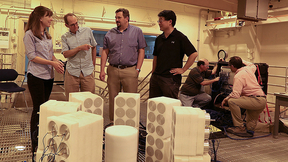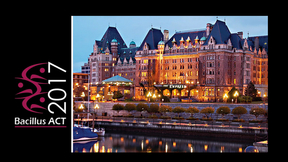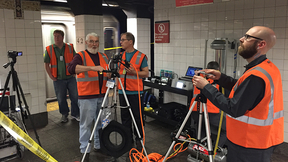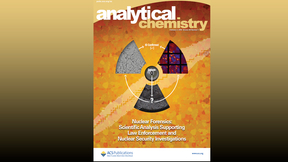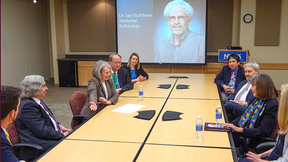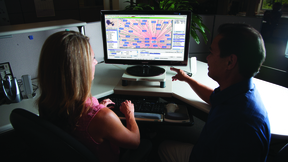Back
Threat preparedness
Lab develops new method for probing material strength
In an effort to better understand how materials deform under extreme conditions, researchers at Lawrence Livermore National Laboratory (LLNL) have developed a new experimental method for probing large-strain and high-rate material strength. In a paper recently published in Acta Materialia, Jonathan Lind, LLNL physicist and lead author, said results of the work aid in…
Kim Budil selected as director of Lawrence Livermore
Kim Budil has been named director of Lawrence Livermore National Laboratory (LLNL). Charlene Zettel, chair of Lawrence Livermore National Security, LLC (LLNS), which manages the Laboratory for the Department of Energy's (DOE) National Nuclear Security Administration (NNSA), made the announcement to Laboratory employees Jan. 28. Budil will begin her new role on March 2…
Lab teams earn DOE Secretary Achievement Awards
Lawrence Livermore National Laboratory (LLNL) employees, participating in 10 project teams, recently earned Department of Energy (DOE) Secretary Achievement Awards. Representing some of the highest internal, non-monetary recognition that DOE employees and contractors can receive, these awards recognize DOE employees and contractors for their service and contributions to…
Warhead replacement program passes first key milestone
Lawrence Livermore National Laboratory (LLNL) researchers passed their first program level key milestone in the W87-1 Modification Program (W87-1 Mod) on Sept. 24, keeping the program on schedule despite work stoppages due to the COVID-19 pandemic. The W87-1 Mod will replace the W78 thermonuclear warhead with a modified design of the W87 warhead. The W78 is nearing the end…
Warhead replacement program passes first key milestone
Lawrence Livermore National Laboratory (LLNL) researchers passed their first program level key milestone in the W87-1 Modification Program (W87-1 Mod) on Sept. 24, keeping the program on schedule despite work stoppages due to the COVID-19 pandemic. The W87-1 Mod will replace the W78 thermonuclear warhead with a modified design of the W87 warhead. The W78 is nearing the end…
Lab delivers innovation jolt with pulsed power modules
Lawrence Livermore National Laboratory (LLNL) researchers delivered four pulsed power modules to Nevada National Security Site (NNSS) this month, making excellent time despite many challenges presented by COVID-19. The modules are key elements in a novel diagnostic capability jointly developed by Los Alamos National Laboratory (LANL), NNSS and LLNL to be deployed in the…
Lab researchers, NASA find space station’s surface microbial profile resembles skin of its crew members
A study conducted by a team of national laboratory and NASA researchers has found that the environment of the International Space Station is affected by the microbial composition of the astronauts themselves. The five-year research effort represents the first study to compare the space station's environmental microbial profile (or microbiome) to an astronaut’s microbiome…
Laboratory researchers describe how antineutrino detectors could aid in nuclear nonproliferation efforts
A tiny, invisible particle could offer help for a big problem — the threat of nuclear proliferation. For more than six decades, scientists have been developing instruments for fundamental physics that can detect antineutrinos, particles that have no electric charge, almost no mass and easily pass through matter. Antineutrinos are emitted in vast quantities by nuclear…
Join the largest online wargaming event ever
The Project on Nuclear Gaming (PoNG) is hosting an online playfest for its first game, SIGNAL, a video game focused on understanding the issues surrounding nuclear deterrence and strategic stability. Thousands have signed up to play SIGNAL since the public launch in May 2019 and the experimental wargaming concept has been featured in the Bulletin of the Atomic Scientists…
Theory aids analysis of nuclear materials
Nuclear emergency teams, safeguards specialists and others may one day benefit from an expanded nuclear fission chain theory and detectors developed by a team of Lawrence Livermore Nationla Laboratory (LLNL) physicists. The Livermore scientists have bolstered their theory for understanding nuclear fission chains -- a cascade of atomic nuclei splitting, each initiated by a…
John Nuckolls to be awarded John S. Foster Jr. Medal for contributions to nuclear security
For more than 60 years, John Nuckolls has dedicated his career to advancing science and technology in support of U.S. national security. In recognition of his outstanding leadership and service to the nation, he has been named the fourth recipient of the John S. Foster Jr. Medal. Established by Lawrence Livermore National Security, LLC (LLNS) and bestowed on an annual…
International anthrax conference to explore latest scientific research findings
Scientists and researchers from all over the world who work on Bacillus anthracis, the causative agent of anthrax, and B. cereus and B. thuringiensis, two closely related bacillus species, will be heading to Victoria, British Columbia, in October for the international conference known as "Bacillus ACT." The bi-annual conference, set for Oct. 1-5, will allow members of the…
LLNL supports NYC subway biodefense test
Lawrence Livermore National Lab (LLNL) researchers took to the New York City subway system May 9-13 to help study how a surrogate for a biological agent, such as anthrax, might disperse throughout the nation’s largest rapid transit system as a result of a terrorist attack or an accidental release. As part of a multi-agency test sponsored by the Department of Homeland…
Experiment aims to advance nuclear monitoring
A Lawrence Livermore National Laboratory (LLNL) team played a key role in fielding the recent Source Physics Experiment (SPE-5) detonated at the Nevada Nuclear Security Site (NNSS).The SPE shots, including the most recent one on April 26, consist of a series of six underground high-explosive detonations in hard rock that are designed to improve the United States’ ability…
Need to know more about nuclear forensics? Lab's analytical chemists have it covered
Two Laboratory scientists have teamed with Australian colleagues to author an overview of nuclear forensics that is featured as the cover story for the Feb. 2 edition of Analytical Chemistry magazine.LLNL analytical chemists Mike Kristo and Ruth Kips, in collaboration with three researchers from the Australian Nuclear Science and Technology Organisation (ANSTO), wrote the…
Moniz awards Ian Hutcheon memorial fellowship
Energy Secretary Ernest Moniz last Thursday awarded the first Office of Defense Nuclear Nonproliferation (DNN) fellowship in honor of the late Ian Hutcheon, a longtime nuclear forensics expert at Lawrence Livermore National Laboratory, to Thomas Gray.Gray serves as a nonproliferation graduate fellow in the National Nuclear Security Administration’s Office of Defense…
Harsh conditions can't contain researchers' efforts to test radiation detection systems
Researchers from five laboratories and a private company recently spent two days in blistering 100 degree heat testing radiation detection technologies amidst cargo containers.The 15 researchers demonstrated the feasibility of using gamma-ray and neutron imaging detectors to identify radioactive materials using the Laboratory’s cargo container stack testbed."The purpose of…
Nonproliferation research nets excellence medal
Anne Harrington, the National Nuclear Security Administration's (NNSA) deputy administrator for Defense Nuclear Nonproliferation, recently presented the NNSA Excellence Medal to Leon Berzins for the successful Source Physics Experiment 4 Prime (SPE4) campaign at the Nevada National Security Site (NNSS).The experiments, designed to provide a better understanding of seismo…
Lawrence Livermore licenses tool to improve government computer network security
Government agencies, along with state and local governments, could receive a helping hand from a computer network security tool developed by Lawrence Livermore National Laboratory (LLNL) computer scientists and engineers. The LLNL software-based technology, known as the Network Mapping System (NeMS), has been licensed to Cambridge Global Advisors, a Washington, D.C.-area…
Lawrence Livermore researchers help biomed company land FDA approval for Ebola detection
Researchers from LLNL and three other institutions have assisted a Bay Area biomedical company in advancing its Ebola virus detection test for use.Sunnyvale-based Cepheid has received an emergency use authorization from the U.S. Food and Drug Administration (FDA) to utilize its polymerase chain reaction (PCR)-based assay for diagnostic purposes."We received a Cepheid…



